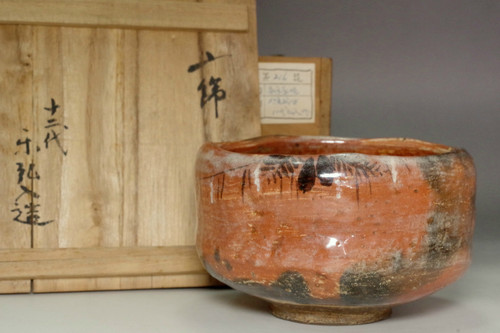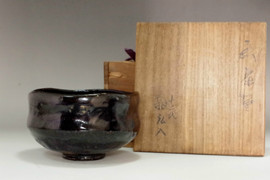Raku 12th Konyu (1857-1932) Aka-Raku Tea Bowl "Shimekazari" #5216
- SKU:
- 5216
- Shipping:
- Free Shipping
Height: approx. 7.4 cm (2 29⁄32 in)
Width: approx. 11.2 cm (4 13⁄32 in)
weight: 330g (w/ box 547g)
Writing on the box: Aka-Raku Teabowl "Shimekazari" by Raku 12th Konyu
condition: small damages in rim
title: shimekazari
origin: Japan
The red Raku tea bowl Shimekazari crafted by the 12th generation Raku Kōnyū is a masterpiece that embodies the traditional beauty of Japan. Designed for use as a matcha tea bowl, this piece fully captures the distinctive softness and profound texture of Raku ware. Its exterior features a warm red base color, enhanced by the natural glaze's flowing dark brown tones, creating an evocative aesthetic that captivates viewers. The glossy glaze on the interior adds a perfect touch, beautifully complementing the vibrant green of matcha during tea ceremonies.
The foot of the bowl is marked with the Raku family seal, serving as a testament to the legacy and craftsmanship of this renowned lineage. The firing marks, rich earthen texture, and natural handmade form further enhance its appeal. The inscription Shimekazari on the base reflects a sense of seasonality and the spirit of tea culture, deepening the narrative and significance of this tea bowl.
In terms of condition, the bowl is overall well-preserved, although there is a minor chip on the rim. The visible signs of use add to its character, narrating its history and dignity as a tea utensil. Particularly striking are the fine details visible under light and the comforting tactile warmth, which can only be fully appreciated when held in hand.
This red Raku tea bowl is not only a functional tool for tea ceremonies but also a highly valuable item for lovers of Japanese culture and antique collectors alike. It represents a harmonious blend of traditional craftsmanship and natural beauty, offering its owner a deeper connection to the world of tea culture.
Shimekazari is a traditional Japanese New Year decoration, typically hung at the entrance of homes or on Shinto altars to welcome the new year. It is made from braided straw and adorned with shide (zigzag-shaped paper strips) and other embellishments. Shimekazari serves as a sacred marker, creating a boundary to ward off impurities and prevent them from entering the space. Additionally, it symbolizes purification and the prayerful preparation for welcoming the deity of the new year (Toshigami-sama). While its design and ornaments vary by region, it is universally regarded as an auspicious item essential for New Year celebrations.

















